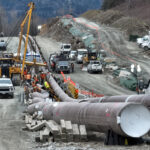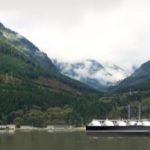From CBC News
Global demand is growing for LNG, providing lifeline for projects still in development
The once sky-high aspirations to develop a liquefied natural gas (LNG) industry on Canada’s West Coast have crashed to the ground, but experts say the window of opportunity has yet to close as demand for the resource continues to rise around the globe.
After several project delays and cancellations, the LNG industry has struggled to take off in British Columbia. Meanwhile, the sector is blossoming in the United States as natural gas pipelines and LNG facilities are constructed.
“Today, we export LNG to 27 nations on five continents,” said U.S. Secretary of Energy Rick Perry in a speech last week at CERAWeek, the global energy conference, in Texas.
Some of the natural gas exported from the United States is produced in Canada and transported south by pipelines.
U.S. LNG exports surging
LNG exports from the U.S. were about 100 million cubic feet per day at the start of 2016 and have grown to about three billion cubic feet per day, according to the U.S. Energy Information Agency. The firm predicts exports will rise to nearly 10 billion cubic feet by the end of 2019.
Canada is desperate to export its natural gas
Canada’s natural gas industry is desperate for even a fraction of that export capacity north of the border. Natural gas prices in Alberta remain depressed without domestic demand growth and insufficient capacity to export.
Former B.C. premier Christy Clark pitched the burgeoning industry as a massive wealth creator for the province, including a pledge in the 2013 throne speech to build a $100 billion prosperity fund from LNG revenues.
Glimmer of hope to the west
But all is not lost on the West Coast, as some proposed LNG export projects are still in development.
The largest is LNG Canada, a consortium led by Shell, which is working toward making a final investment decision on the $40 billion project in Kitimat, B.C. Last month, the consortium announced it was short-listing two major international engineering and construction groups for the design, procurement and construction of the LNG plant.
Shell is the world’s largest LNG company after acquiring BG Group in 2016 and the company’s chief executive believes the sector has a bright future.
“LNG demand has been growing at four times the rate of oil demand and I think it will continue to do so for many years, if not decades to come,” said Shell CEO Ben van Beurden, while at CERAWeek.
“Investment has dried up a bit. I think this is probably not a bad time to start considering again investment in supply of new LNG projects and I suppose if we don’t do that, we’ll see a bit of a crunch coming in the early [2020s].”
The main challenge facing West Coast LNG project proposals is their cost, according to Enbridge CEO Al Monaco. In an interview with CBC News at CERAWeek, the chief executive said the projects need to become competitive with building a similar project in the Gulf Coast of the U.S.
“What we need to do is focus on getting the costs down for building pipelines and building LNG facilities, that’s what we got to do next,” he said. “Industry can work on cost structure within pipelines and LNG. Governments can facilitate by ensuring a smooth regulatory process and support for natural resource development. It’s a fantastic opportunity.”
LNG export facilities take several years to construct, so companies would need to start construction soon in order to be up and running by 2021 or 2022, say experts.
From LNG Canada
LNG Canada is a joint venture company comprised of four global energy companies with substantial experience in liquefied natural gas (LNG) – Shell, PetroChina, KOGAS and Mitsubishi Corporation. Together, we are proposing to design, build and operate an LNG export terminal in Kitimat, British Columbia.
We chose British Columbia because it has the second largest natural gas reserves in Canada and is a reasonable shipping distance from Asian markets. We identified more than 500 possible locations in BC, then began the process of narrowing that number to just a handful before settling on our location in Kitimat, B.C., at the head of Douglas Channel.
If the LNG Canada project is approved for construction, key features of our proposed facility would include:
- LNG Processing Units: Natural gas will enter the processing units, or ‘trains’ – where carbon dioxide, water, condensate, sulphur and any other impurities will be separated out. The gas will then be chilled to approximately -162 degrees Celsius and turned into LNG. Condensates will be stored and railed out to market.
- Storage Tanks: LNG will be piped to storage tanks until it is loaded onto LNG carriers at the wharf.
- LNG Loading Lines: Two LNG loading lines will transfer LNG from the storage tanks to the wharf and the LNG carrier. They will be insulated to conserve energy and to keep the LNG in its liquid form.
- Marine Terminal: An existing wharf will be redesigned to accommodate up to two LNG carriers at a time. Every LNG carrier will be assisted at the terminal by up to three tugboats – tugs will maneuver alongside the LNG carrier, positioning it at a very low speed until the LNG carrier is secured at the berth.
- Rail Yard: The rail yard inside the facility will be connected into an existing rail system, which will be used to load condensate, a petroleum liquid that is one of the natural by-products of turning natural gas into LNG. The condensate will be stored temporarily in tanks on the site and then transported off-site by rail car for sale to customers.
- Water Treatment Facility: The facility will draw water from the Kitimat River for use in process cooling, drinking and other purposes. Water taken from the river will be treated as needed prior to use. Water will be reused in a closed loop system to reduce water loss. Most of the water used by the cooling system will evaporate during use. Water that does not evaporate will be treated, along with any other facility wastewater, in an on-site wastewater treatment facility before releasing it into Kitimat Arm.
- Flare Stacks: Two flare stacks – one that is approximately 60 metres tall and a second that is approximately 125 metres tall – will act as safety devices, a common feature in all LNG facilities. When the facility is operating normally, residents can expect to see a relatively small clean burning flame (essentially, a pilot light) at the top of the stacks. The size of this pilot light will be approximately three feet in height, and will likely not be visible during the day.
From Woodfibre LNG
Woodfibre LNG Limited is proposing to build a modestly-sized liquefied natural gas (LNG) processing and export facility at the former Woodfibre pulp mill site, about seven kilometres southwest of Squamish, British Columbia, Canada. The Project capital costs are expected to be in the range of $1.4 to $1.8 billion (2014 CAD).
Woodfibre LNG is licenced by the NEB to export about 2.1 million tonnes of LNG per year for 40 years.
The Woodfibre LNG Project is owned and operated by Woodfibre LNG Limited, a privately held Canadian company based in Vancouver, British Columbia. We are a subsidiary of Pacific Oil & Gas Limited, which is part of the Singapore-based RGE group of companies.
RGE, also known as Royal Golden Eagle, manages a group of resource-based manufacturing companies with global operations. The RGE group of companies’ work ranges from the upstream, comprising sustainable resource development and harvesting, to downstream, where the companies create diverse value-added products for the global market. Assets held by the RGE group of companies exceed US$18 billion with a combined workforce of more than 60,000 people worldwide.
One of the first questions we hear is “Why are you locating your facility here in Squamish?”
The answer is pretty straight forward. We began by looking all across North America for a suitable site. Our criteria focussed mainly on whether there was existing infrastructure and a welcoming regulatory regime.
We wanted to distinguish ourselves from many of the larger projects you may have heard about – instead of building brand new large-scale infrastructure, we were looking for a project where most key elements were already in place and optimal for conversion to an LNG facility. What we found at the Woodfibre site was:
- A site with an existing pipeline and an existing electricity transmission line – meaning minimal upgrades to infrastructure, which shortened timelines and minimized environmental impact.
- A deepwater port.
- A history of industrial use. It is zoned industrial by the municipality of the District of Squamish and is considered as a location for “industry and employment” under the Official Community Plan (OCP).
With these factors in place, an LNG facility on newly cleaned up land would not create a new impact on the land base. The footprint of the potential LNG facility will likely be smaller than the footprint of the old pulp mill providing further opportunities for site remediation and green space.
When Woodfibre LNG Limited’s ownership was looking for the right location to build and operate a modestly-sized LNG processing and export terminal in British Columbia, the Woodfibre site on the shores of Howe Sound was by far the best fit. The brownfield site was home to pulp mill operations for 100 years, is zoned industrial, and has a deep water port on a waterway that for decades has been used for commercial shipping. The Woodfibre site also has access to electricity from BC Hydro and a FortisBC natural gas pipeline. To learn more about the FortisBC Eagle Mountain – Woodfibre Gas Pipeline Project, visit here.
From Kitimat LNG
The proposed Kitimat LNG project is a 50/50 joint venture between Chevron Canada Limited (Chevron) and Woodside Energy International (Canada) Limited (Woodside) through the entire value chain.
The project consists of:
- Development of significant natural gas resources found in shale and tight rock formations in the Liard and Horn River Basinslocated in northeastern B.C.
- Transportation of that gas across northern B.C. via a third party pipeline and the Pacific Trail Pipeline(PTP) to the Kitimat LNG liquefaction facility at Bish Cove near Kitimat B.C.
- The Kitimat LNG liquefaction facility at Bish Cove will cool the gas into a liquid for shipping to overseas markets.
During construction, the Kitimat LNG facility at Bish Cove and Pacific Trail Pipeline will create approximately 4,500 jobs in B.C. Additional jobs will also be created during the development of the significant natural gas resources located in the Liard and Horn River Basins in northeastern British Columbia.
Kitimat LNG has a 20 year, 10 million-metric-tonne-per-year LNG export license from the National Energy Board and all of the major provincial and federal environmental assessment certificates for the proposed Kitimat LNG plant and the Pacific Trail Pipeline are in place.
The Kitimat LNG facility will be built on land leased from the Haisla Nation (IR 6) under a unique benefits agreement. Significant early works at the proposed site began in 2011 and full construction of the facility will begin once a Final Investment Decision (FID) is made.
British Columbia stands to be the biggest beneficiary of the Kitimat LNG project for decades to come. Benefits such as employment, skills training, contracting and revenues to First Nations, local, B.C., and Canadian businesses are already taking place.







